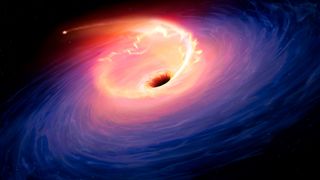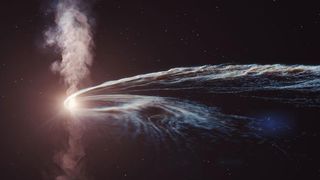Distant Galaxy's Voracious Black Hole
"When a star dangerously approached a black hole -- no worries, this will not happen to the sun -- it is violently ripped apart by the black hole's gravitational tidal forces similar to how the moon pulls tides on Earth but with greater strength.""Then, pieces of the star are captured into a swiftly spinning disk orbiting the black hole. Finally, the black hole consumes what remains of the doomed star in the disk.""In some very rare cases, which we estimated to be 100 times rarer, powerful jets of material are launched in opposite directions when the tidal disruption event occurs."Michael Coughlin, astronomer, University of Minnesota
 |
In one of only four examples, the first detected since 2011, a black hole has been observed while ripping a passing star apart in a phenonenon referred to as a tidal disruption. Following which luminous jets of high-energy particles were launched into space, according to researchers. No previous such event has ever been sighted. The event was described in two studies, each published in the journals Nature and Nature Astronomy.
The Zwicky Transient Facility astronomical survey detected the event in February, with the use of a camera to which was appended a telescope, at the Palomar Observatory in California. Using the European Southern Observatory's Very Large Telescope located in Chile, enabled the calculation of the distance involved.
The sighting captured the epic drama of a supermassive black hole -- whose size is estimated to be hundreds of millions of times the mass of our sun -- whose location is approximately 8.5 billion light years' distance from Earth, shredding and swallowing a large, bright star that had 'wandered' too close in proximity to this massively rapacious black hole with its overwhelming gravitational grasp. (The disance that light travels in a year is termed a 'light year').
 |
"We think that the star was similar to our sun, perhaps more massive but of a common kind", explained astronomer Igor Andreoni, of the University of Maryland and NASA's Goddard Space Flight Center, who was lead author of one of the studies.
Both astronomers, Andreoni and Coughlin, described the black hole as in all probability spinning rapidly, which might explain how it was that two powerful jets were launched into space at close to the speed of light. Astronomer Dheeraj Pasham, lead author of the other study -- with the Massachusetts Institute of Technology -- explained that the researchers had been able to observe the event early in its occurrence -- within a week of the black hole beginning to consume the star.
Most galaxies have a black hole at their core. The supermassive black hole involved in this epic cosmic event is believed to centre a galaxy similar to our own galaxy, the Milky Way, although located far distant from our galaxy. The astonishing tidal disruption event was bright enough that it obscured the light of the stars situated in the black hole's galaxy.
 |
| This animation depicts a star experiencing spaghettification as it’s sucked in by a black hole during a ‘tidal disruption event’. Credit: ESO/M. Kornmesser |
Labels: Astronomy, Black Hole, Shredded Star

0 Comments:
Post a Comment
<< Home